Đối với các dự án chiếu sáng thương mại, nếu bạn ưu tiên cung cấp điện ổn định đường dài, độ sáng ổn định và tuổi thọ, thì dải LED dòng điện liên tục chắc chắn là sự lựa chọn vượt trội. Tuy nhiên, nếu ngân sách dự án có hạn, khoảng cách lắp đặt ngắn và không có yêu cầu nghiêm ngặt về độ đồng nhất độ sáng, thì dải đèn LED điện áp không đổi mang lại giá trị tốt hơn cho tiền.
Các dải LED điện áp không đổi và dòng điện không đổi, mỗi dải đều có ưu điểm riêng: loại trước đây có thiết kế mạch đơn giản và chi phí thấp hơn, phù hợp với chiếu sáng trang trí cự ly ngắn; sau này cung cấp dòng điện ổn định và tuổi thọ cao hơn, làm cho nó lý tưởng cho các ứng dụng thương mại quy mô lớn hoặc cao cấp. Hiểu được các nguyên tắc và đặc điểm của hai phương pháp truyền động này có thể giúp bạn đưa ra quyết định đúng đắn trong các tình huống thương mại khác nhau.
Bài viết này sẽ cung cấp phân tích chuyên sâu về sự khác biệt kỹ thuật, ưu điểm và nhược điểm, kịch bản ứng dụng và khuyến nghị lựa chọn cho các dải LED điện áp không đổi và dòng điện không đổi, cung cấp hướng dẫn cho các dự án chiếu sáng thương mại của bạn.
vật gì TÔIchữ thứ 19 nốt thứ sáu trong nốt đôtới nốt đôđèn LED SChuyến đi?
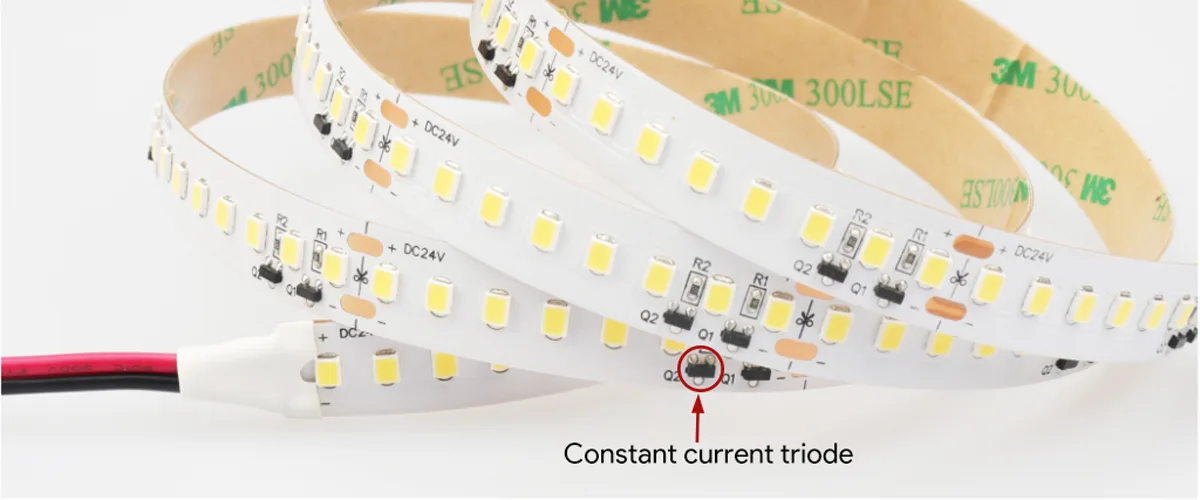
nốt thứ sáu trong Dải LED hiện tại không đổi là một loại dải LED duy trì dòng điện không đổi qua đèn LED của nó. Dòng điện được điều chỉnh và duy trì bởi một nguồn dòng điện liên tục.
Các dải LED dòng điện không đổi thông thường thường kết hợp các IC hiện tại không đổi hoặc bóng bán dẫn triode trên chính dải hoặc có chip hiện tại không đổi tích hợp bên trong đèn LED. Tính năng cốt lõi của chúng là điều khiển chính xác dòng điện để đạt được ánh sáng ổn định, làm cho chúng phù hợp cho các ứng dụng có yêu cầu nghiêm ngặt về độ sáng và tuổi thọ.
nguyên tắc làm việc
Như thể hiện trong hình dưới đây, khi một dải LED dòng điện không đổi đang hoạt động, chất bán dẫn dòng điện không đổi (IC hoặc bóng bán dẫn triode) xuất ra dòng điện không đổi 25mA thông qua mạch tích hợp bên trong của nó, trong khi điện áp tự động điều chỉnh dựa trên số lượng đèn LED nối tiếp. Nếu một đèn LED có điện áp 3V, ba đèn LED nối tiếp yêu cầu điện áp 9V. Khi điện áp đầu vào từ 10 - 14V, dòng điện vẫn ở giá trị đặt trước là 25mA, ngăn chặn độ sáng nhấp nháy hoặc quá tải LED.
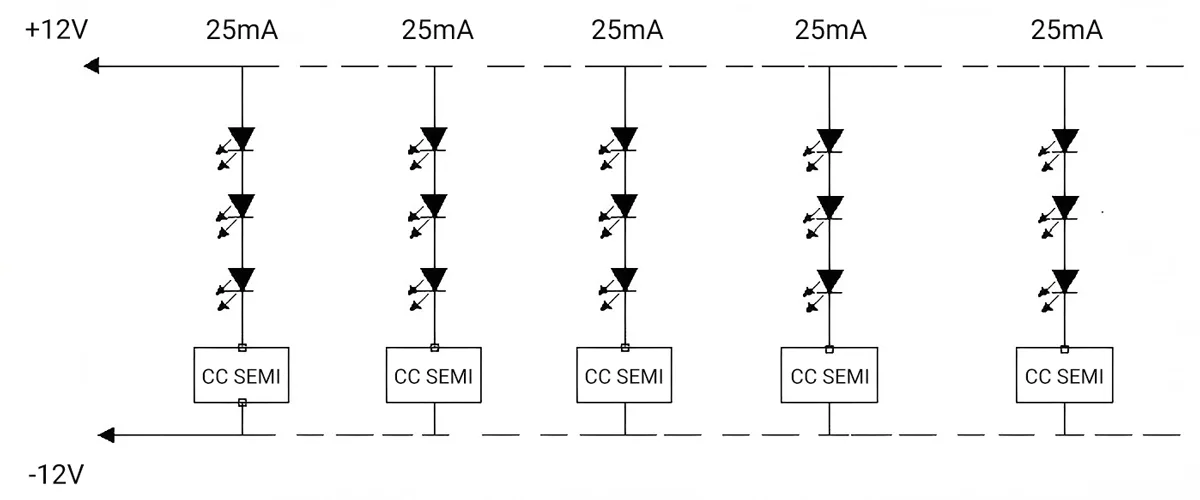
Dãy-pbài hát ngắn nốt đôbất tỉnh Ssự kết án
Như thể hiện trong hình bên dưới, các đèn LED trong dải LED dòng điện không đổi được thiết kế với cấu hình song song. Mỗi nhóm cách nhau 50mm, tổng cộng có 3 nhóm. Mỗi nhóm được điều khiển độc lập bởi một bóng bán dẫn dòng điện không đổi, đảm bảo rằng dòng điện trong mỗi nhóm bằng nhau và độ sáng của đèn LED trong mỗi phân đoạn là đồng nhất.

Lợi thế kỹ thuật dải LED hiện tại không đổi
| những phẩm tính | sự hiệu lực |
| Độ sáng nhất quán | Không giảm điện áp hoặc phân rã ánh sáng trên khoảng cách dài (> 8 mét), với độ sáng thay đổi <5% |
| tuổi thọ | Chip bù nhiệt độ âm tích hợp, tự động giảm dòng điện ở nhiệt độ cao, phân rã ánh sáng ≤10% trên 5 năm |
| an toàn | Cơ chế bảo vệ quá tải ngăn chặn một đèn LED hỏng duy nhất khiến toàn bộ dải ánh sáng bị trục trặc |
| 3 khả năng chống nhiễu | Dòng điện vẫn ổn định ngay cả khi điện áp đầu vào dao động ± 30% (dung dịch điện áp liên tục với dao động ± 10% có thể gây ra hiện tượng tăng đột biến dòng điện lên đến 50%) |
Các kịch bản ứng dụng
- Hệ thống phòng trưng bày trung tâm mua sắm: Điều chỉnh độ sáng vô cấp mà không nhấp nháy; ánh sáng đường viền tòa nhà dài (như bên ngoài khách sạn, đường hầm).
- Môi trường làm việc chính xác: Chiếu sáng không bóng trong các xưởng điện tử (loại bỏ nhiễu nhấp nháy khi sản xuất), chiếu sáng phụ trong phòng mổ y tế.
- Những ngôi nhà cao cấp: Custom Case Chiếu sáng xung quanh (lắp đặt nhúng với độ sáng đồng đều), chiếu sáng trần gián tiếp (tạo hiệu ứng chiếu sáng gradient).
- bản chất kỹ thuật: Dải LED dòng điện không đổi đạt được điều khiển vòng kín hiện tại thông qua chip vật lý, khác với giải pháp dải LED điện áp không đổi đơn giản hơn dựa vào điện trở giới hạn dòng điện. Đây là giải pháp được ưu tiên trong việc chiếu sáng LED giúp cân bằng hiệu suất và độ tin cậy.
vật gì nốt thứ sáu trongnốt thứ hai trong số kim hiệuanh ta chính các loại dải LED dòng điện không đổi?
1. Dải LED dòng điện không đổi dựa trên IC điện áp thấp
Các dải LED này thường hoạt động ở điện áp đầu vào là 12V hoặc 24V. Mỗi đoạn của dải được thiết kế với các bóng bán dẫn hoặc IC để duy trì dòng điện không đổi. Bằng cách sử dụng các bóng bán dẫn triode rời, các dải này đạt được điều khiển dòng điện không đổi chi phí thấp, làm cho chúng phù hợp cho các ứng dụng đơn giản.
IC các giải pháp hiện tại liên tục dựa vào chip điều khiển chuyên dụng và vi điều khiển để đạt được điều khiển đa kênh có độ chính xác cao, có thể lập trình được. Dải LED được điều khiển qua SPI hoặc DMX512, chẳng hạn như dải LED thay đổi màu sắc, thuộc loại dải LED dòng điện liên tục và phù hợp cho dải LED thông minh cấp thương mại.
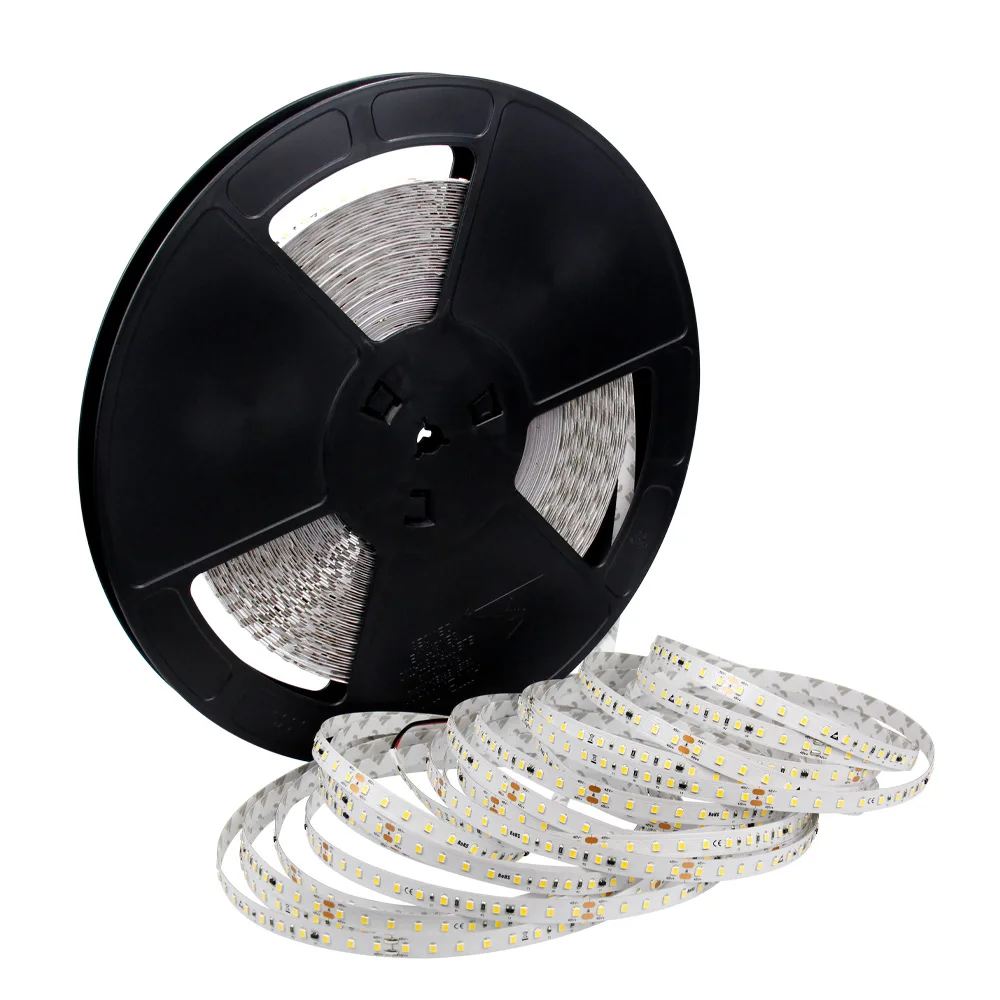
Đèn LED chạy dài dòng điện DC24V / DC48V
Mô hình chính: FQW10T120D
Loại LED: SMD2835
Số lượng đèn LED trên một mét: 120
Chiều rộng PCB: 10mm/12mm
Chiều dài: 10m/15m/20m/30m/40m/50m
Điện áp đầu vào: DC24V/DC48V
Công suất trên mét: 10W/7.2W
Nhiệt độ màu: 2700k/3000k/4000k/5000k/6500k/có thể tùy chỉnh
IP cấp: IP20/IP54/IP65/IP67/IP68
Bảo hành: 3 năm

Đèn LED dải địa chỉ DC12V / 24V RGB
Mô hình chính: FAA10T060C
Led QTY tùy chọn tùy chọn: 60
Loại LED: SMD5050
Tùy chọn chiều rộng PCB: 10mm
Màu sắc: rgb
Loại IC: WS2811/UCS1903/TM1812, IC bên ngoài
Số lượng pixel: 20/10 pixel mỗi mét, 1 điểm ảnh 3/6 LED
Kiểu dữ liệu: Tín hiệu SPI, dòng dữ liệu đơn
Điện áp đầu vào: DC12V/DC24V
Công suất trên mét: 12W
Tùy chọn cấp độ IP: IP20/IP54/IP65/IP67/IP68
Bảo hành: 3 năm
2. Dải LED hiện tại của trình điều khiển không đổi
Được cung cấp trực tiếp bởi một trình điều khiển dòng điện không đổi, các dải ánh sáng này không yêu cầu điện trở hoặc bóng bán dẫn để giới hạn dòng điện. Chúng có hiệu suất phát sáng cao, với điện áp đầu vào thường được đặt trong phạm vi từ 22V đến 40V.
Các dải LED cứng này sử dụng trình điều khiển dòng điện không đổi để cung cấp dòng điện một chiều ổn định. Về nguyên tắc, các đèn LED được nối nối tiếp và sau đó được nối với các đầu cực dương và âm chính, đảm bảo điện áp nhất quán trên mỗi phần của dải ánh sáng.
những Dải ánh sáng cứng hiện tại không đổi Có yêu cầu tương thích nguồn điện cao; tổng mức tiêu thụ dòng điện của dải ánh sáng phải phù hợp với dòng điện đầu ra của nguồn điện để đạt được độ chiếu sáng LED tối ưu. Các dải ánh sáng này phù hợp với độ dài tùy chỉnh và môi trường lắp đặt khoảng cách ngắn.
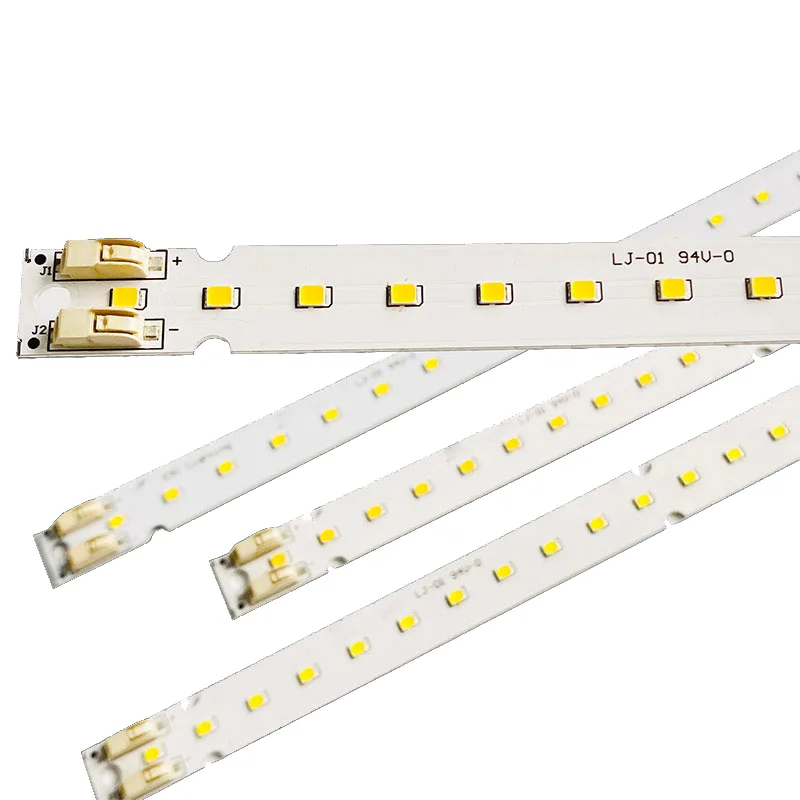
Mô-đun LED tuyến tính PCB hiện tại không đổi
Mô hình chính: SL-5.5-XX-10
Điện áp: Tối đa 28,5V
Đầu vào hiện tại: Tối đa 150mA
Đầu vào watt: Tối đa 4.425W
Hiệu quả phát sáng: 195lm / W
Các loại LED: SMD2835
Nhiệt độ màu: 2700K - 6500K
CRI: 80/90
Kích thước: 139,7 × 15,24 × 1,6mm
Chứng nhận: CE, Rohs
Bảo hành: 5 năm
3. Dải đèn LED cao áp
Dải LED cao áp 110V/220V thường sử dụng công nghệ truyền động dòng điện không đổi. Nguyên tắc cốt lõi liên quan đến việc chuyển đổi điện áp AC 110V / 220V từ nguồn điện thành điện áp một chiều phù hợp cho đèn LED trong khi vẫn duy trì dòng điện ổn định.
Bộ điều hợp trình điều khiển như vậy thường có chức năng đầu ra hiện tại không đổi. Ví dụ, chip PM2043 được sử dụng để điều khiển dây đèn LED cao áp chạy bằng điện chính, đạt được điều khiển dòng điện liên tục tuyến tính nhiều phân đoạn thông qua công nghệ phân chia sóng hài. Thích hợp cho các ứng dụng đường dài như chiếu sáng profile kiến trúc và trang trí ngoài trời, dải đèn LED cao áp đòi hỏi phải bảo vệ cách nhiệt trong quá trình sử dụng.
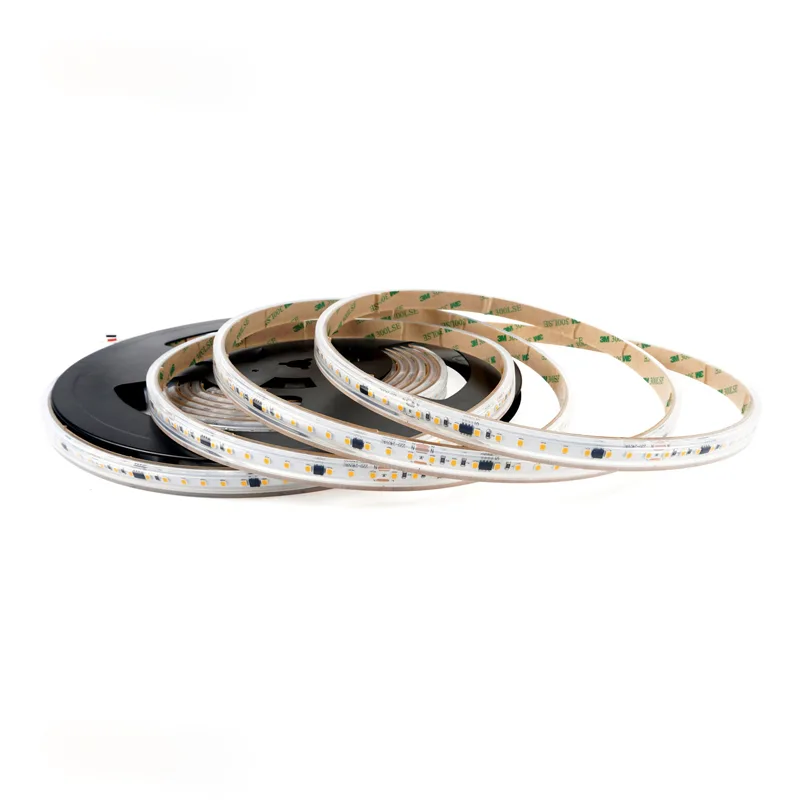
Đèn LED dải cao áp
Mô hình chính: GQX10T120G
Led QTY tùy chọn tùy chọn: 60/80/120
Đồng hồ đo mỗi cuộn: Tối đa 100m
Tùy chọn chiều rộng PCB: 10mm/12mm
Tùy chọn màu sắc: 2700k/3000k/4000k/5000k/6500k/rgb
Tùy chọn CRI: 80/90
Điện áp đầu vào: AC120V/AC220V
Công suất trên mét: 7W / 10W
Tùy chọn cấp độ IP: ip67 / ip68
Bảo hành: 3 năm
Dải LED hiện tại không đổi mang lại nhiều lợi thế. Dưới cùng một định mức công suất, các dải LED dòng điện không đổi cung cấp độ sáng cao hơn các dải LED điện áp không đổi. So với các dải LED điện áp không đổi điện áp thấp thường được sử dụng, chúng ít bị sụt áp hơn, đảm bảo độ sáng đồng đều từ đầu đến cuối dải.
Dải đèn LED điện áp không đổi là gì?
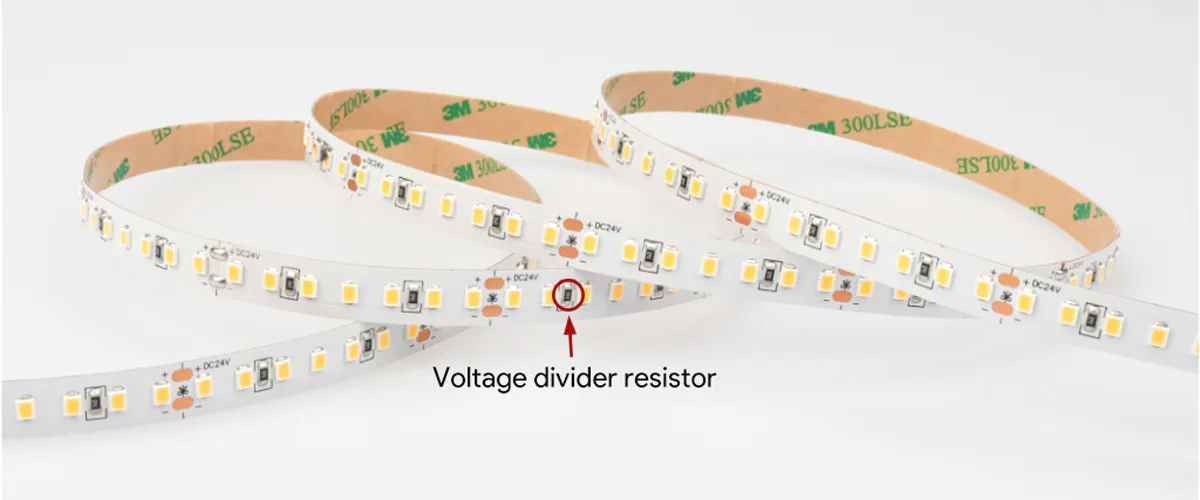
nốt thứ sáu trong dải đèn LED điện áp không đổi là dải LED dựa trên điều khiển điện áp không đổi, giúp điều khiển chip LED phát ra ánh sáng bằng cách tạo ra điện áp ổn định từ nguồn điện. Mỗi nhóm đèn LED thường được kết nối nối tiếp theo nhóm từ 3 đến 6, dựa trên điện áp yêu cầu, để đạt được ổ điện áp không đổi. Dải LED điện áp không đổi là một trong những loại dải LED được sử dụng phổ biến nhất, với điện áp hoạt động thường được đặt ở 12V, 24V, v.v.
Nguyên lý hoạt động của chúng dựa vào nguồn điện một chiều ổn định được cung cấp bởi nguồn điện có điện áp không đổi. Cấu trúc LED thường được thiết kế theo cấu hình song song hoặc song song, với các điện trở để giới hạn dòng điện để đảm bảo khả năng tương thích với các yêu cầu tải khác nhau trong điều kiện điện áp không đổi. Nếu công suất cấp điện quá cao, độ sáng LED sẽ quá cao, làm giảm tuổi thọ; ngược lại, nếu công suất quá thấp, độ sáng sẽ không đủ, ảnh hưởng đến hiệu suất.
Ví dụ, trong dải LED 12V, mỗi đèn LED trắng có điện áp xấp xỉ 3V. Khi kết nối với nhau 3 đèn LED, tổng điện áp là 9V. Do đó, nguồn điện 12V phù hợp cho các đơn vị bao gồm ba đèn LED nối tiếp, với điện trở được sử dụng để phân chia điện áp 3V và giới hạn dòng điện. Nếu cần công suất cao hơn, nhiều đơn vị như vậy có thể được kết nối song song, với tổng dòng điện là tổng dòng điện từ mỗi đơn vị.
Như hình bên dưới: Một đèn LED dải nhỏ 2835, mỗi nhóm gồm 3 đèn LED, mỗi nhóm có điện áp 9V, tương thích với nguồn điện 12V. Dải LED 12V dài 1 mét chứa 120LED (40 nhóm × 3 đèn LED), với mỗi nhóm vẽ khoảng 25mA dòng điện, dẫn đến tổng dòng điện là 1A (40 nhóm × 25mA) và tổng công suất là 12W (12V × 1A).
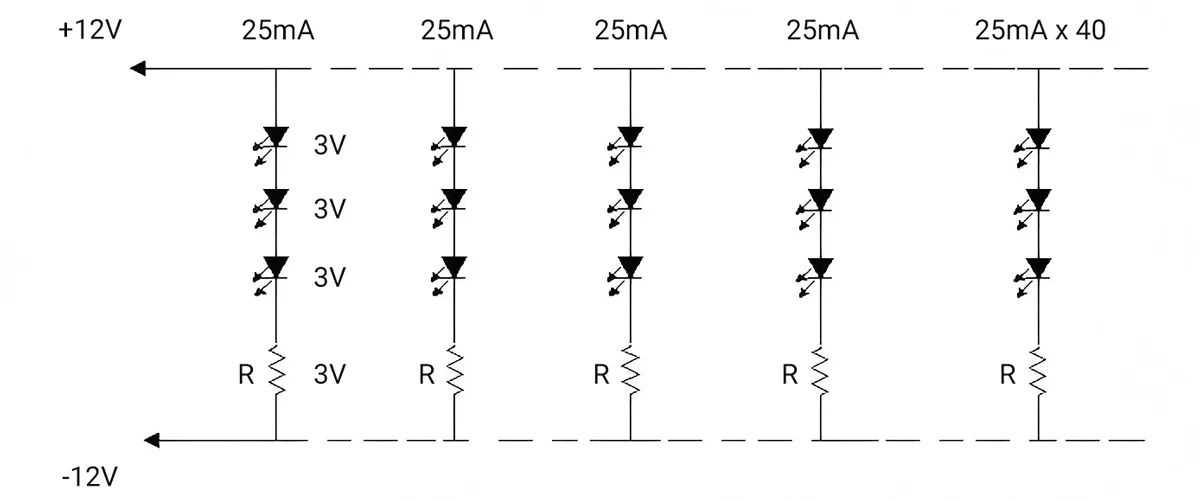
Dải LED điện áp không đổi thích hợp cho các ứng dụng mà độ sáng và độ ổn định màu sắc không quan trọng, chẳng hạn như chiếu sáng tủ bếp, bảng hiệu, hoặc ánh sáng trang trí, và hỗ trợ công nghệ làm mờ cơ bản. Tuy nhiên, chiều dài của dải đèn LED bị giới hạn (thường không quá 5 mét) và chiều dài dài hơn có thể dẫn đến giảm điện áp và độ sáng không đồng đều ở các đầu (chênh lệch độ sáng giữa đầu và cuối có thể đạt 30%-50%).
So với các dải LED dòng điện không đổi, dải LED điện áp không đổi có điện áp đầu ra cố định nhưng dòng điện dao động, dẫn đến chi phí lắp đặt thấp hơn nhưng tính đồng nhất kém hơn; dải LED dòng điện không đổi duy trì dòng điện không đổi trong khi điện áp thay đổi theo tải, cho phép cung cấp điện ở khoảng cách xa hơn.
Điện áp không đổi so với dòng điện không đổi: Dải đèn LED nào tốt nhất cho các dự án thương mại?
tính chắc chắn
Hạn chế của dải LED điện áp không đổi là khi điện áp giảm, dòng điện có thể giảm đáng kể. Khi chiều dài của loạt vượt quá 5 mét, độ sáng của dải đèn LED ở đầu và cuối có thể không nhất quán, với phần phía trước sáng hơn và phần phía sau có vẻ mờ hơn.
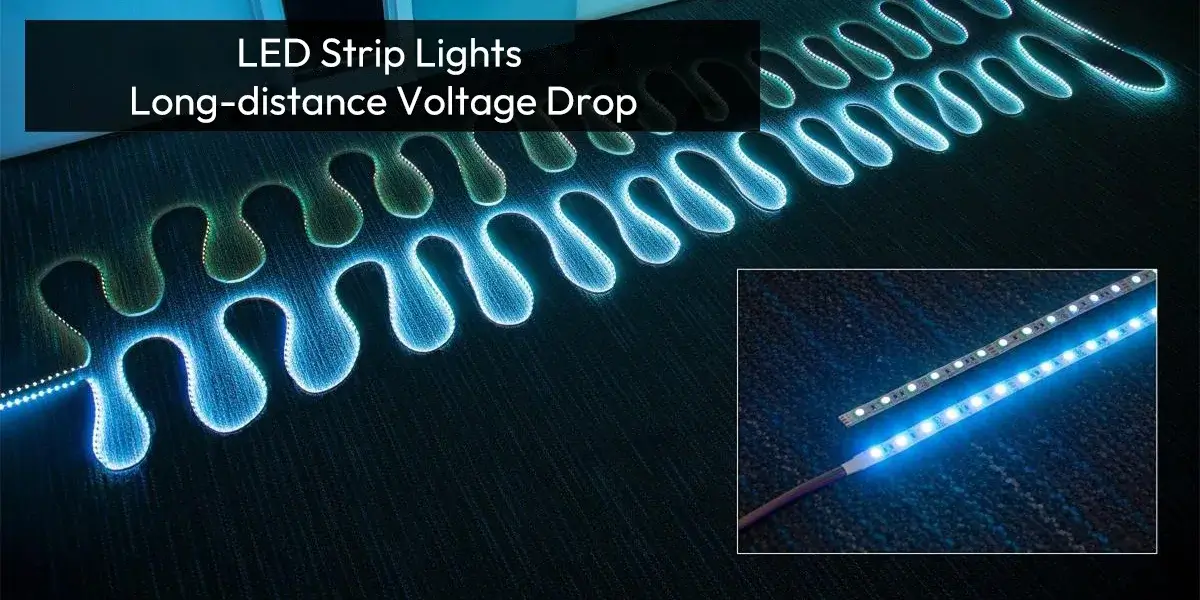
Dải LED dòng điện không đổi duy trì dòng điện không đổi bằng cách sử dụng chip chuyên dụng hoặc bóng bán dẫn có điện áp thích ứng; ngay cả khi điện áp dao động trong một phạm vi nhất định, dòng điện qua mỗi đèn LED vẫn không đổi. Do đó, công suất không đổi, và độ sáng của đèn LED phía trước và phía sau vẫn nhất quán.
Hình dưới đây cho thấy sự so sánh dữ liệu kiểm tra điện áp và điện áp cho các dải đèn LED điện áp không đổi và dòng điện không đổi DC của chúng tôi trên khoảng cách từ 1 đến 5 mét:
| số kim hiệuype | nốt đôsự dâm đảng | 1m | 2m | 3M | 4m | 5m |
| cc dẫn ssự hụt chân | điện áp | 23,84V | 23,45V | 22,83V | 22.0V | 21.02V |
| quyền thay mặt | 16,08W | 31,68W | 47,52W | 63,12W | 80,64W | |
| cv dẫn ssự hụt chân | điện áp | 23,97V | 23,64V | 23,15V | 22,58V | 21,96V |
| quyền thay mặt | 16W | 31,2W | 44,44W | 55,92W | 65,4W |
Từ số liệu so sánh trong hình trên, có thể thấy điện áp của dải ánh sáng không đổi dòng điện giảm từ 24V xuống 21V sau 5 mét, với công suất 80,64W. Công suất trung bình trên mỗi mét được tính là 16W. Công suất sau 5 mét rất gần với công suất của đồng hồ đầu tiên, cho thấy công suất trung bình trên mỗi mét được tính là 16W. Công suất sau 5 mét rất gần với công suất của đồng hồ đầu tiên, cho thấy công suất trung bình trên mỗi mét được tính là 16W. Công suất sau 5 mét rất gần với công suất của đồng hồ đầu tiên, cho thấy công suất trung bình trên mỗi mét được tính là 16W. Công suất sau 5 mét rất gần với công suất của đồng hồ đầu tiên, cho
Bây giờ chúng ta hãy xem xét dữ liệu cho một dải điện áp không đổi khác. Sau 5 mét, công suất là 65,4W, với công suất trung bình khoảng 13W mỗi mét. Có thể thấy khi điện áp giảm, công suất của dải điện áp không đổi giảm đáng kể sau 5 mét, với mức giảm trực tiếp khoảng 20%.
Sự giảm công suất cho thấy dòng điện cũng giảm, khiến đèn LED phát ra ít ánh sáng hơn so với đèn ở phía trước. Do đó, về độ ổn định, dải LED dòng điện không đổi vượt trội hơn so với dải LED điện áp không đổi.
An toàn và độ tin cậy
Trong các dải LED điện áp không đổi, ngay cả những dao động điện áp nhỏ cũng có thể gây ra những thay đổi đáng kể về dòng điện. Nếu một đèn LED trong mạch bị chập và hỏng, nó có thể làm cho điện áp của các đèn LED khác tăng lên, dẫn đến sự gia tăng dòng điện và có khả năng làm hỏng các đèn LED đó.
Các trình điều khiển dòng điện không đổi hỗ trợ các kết nối nối tiếp và song song, với mỗi chuỗi đèn LED nhận dòng điện không đổi độc lập. Nếu một đèn LED bị tắt, chip điều khiển sẽ tự động điều chỉnh điện áp để đảm bảo các đèn LED khác tiếp tục hoạt động bình thường. Do đó, ngay cả khi một đèn LED duy nhất bị lỗi, các đèn LED còn lại trong dải đèn LED dòng điện không đổi vẫn tiếp tục hoạt động bình thường.
tính mạng
Ổ đĩa dòng điện không đổi duy trì dòng điện không đổi thông qua điều khiển vòng kín (với độ chính xác ± 0,3%), ngay cả khi điện áp đầu vào dao động ± 15% hoặc thay đổi nhiệt độ, do đó tránh được các vấn đề như đèn LED quá nhiệt, phân rã ánh sáng tăng tốc hoặc cháy do thay đổi dòng điện đột ngột. Dữ liệu phòng thí nghiệm cho thấy dung dịch dòng điện không đổi có thể kiểm soát sự phân rã ánh sáng trong 5 năm đến ≤10%, trong khi dung dịch điện áp không đổi có thể giảm một nửa tuổi thọ khi điện áp dao động.
Để biết thêm thông tin về tuổi thọ ánh sáng dải LED, hãy đọc bài đăng trên blog “Tuổi thọ ánh sáng dải LED: Chúng tồn tại trong bao lâu và tại sao?”
Cài đặt và bảo trì
Dải LED điện áp không đổi hoặc dòng điện không đổi có điện áp cố định và các phương pháp kết nối linh hoạt, cho phép mở rộng công suất thông qua kết nối song song, phù hợp cho các tình huống yêu cầu lắp ráp linh hoạt (ví dụ: thiết kế dải LED tùy chỉnh). Đối với các dải LED điện áp không đổi được lắp đặt trên khoảng cách dài (> 5 mét) hoặc dải LED dòng điện không đổi được lắp đặt trên khoảng cách xa (> 8 mét), các biện pháp phải được thực hiện để giảm thiểu ảnh hưởng của sự sụt giảm điện áp trong mạch. Điều này liên quan đến việc lắp đặt bù công suất để ngăn điện áp giảm gây giảm độ sáng LED và đầu ra ánh sáng không ổn định.
Ngoài ra, tổng công suất của dải ánh sáng và nguồn điện phải được khớp chặt chẽ. Nếu quá nhiều thiết bị được kết nối song song, tổng dòng điện có thể vượt quá dòng điện định mức của nguồn điện, gây ra quá nhiệt hoặc hư hỏng. Ví dụ, nguồn điện 12V với dòng điện định mức 2A có thể dẫn động tổng dòng tải lên đến 2A (ví dụ: 100 nhóm 3 đèn LED được kết nối song song, mỗi nhóm vẽ 20mA; vượt quá mức này sẽ gây quá tải).
Các dải LED điện áp không đổi thông thường có thể thấy độ sáng của chúng giảm xuống dưới 70% sau ba năm, trong khi các dải LED dòng điện không đổi duy trì tốc độ giữ độ sáng ≥95% sau ba năm, với mức giảm 70% trong phân rã ánh sáng. Sự cố của một đèn LED không ảnh hưởng đến hoạt động tổng thể, loại bỏ sự cần thiết phải thay thế toàn bộ phần.
phí tổn
Dải đèn LED điện áp không đổi có hiệu quả về chi phí, có mạch đơn giản và có thể được cắt tự do để phù hợp với các hình dạng cong mà không có nguy cơ thay đổi dòng điện đột ngột sau khi cắt. Thích hợp cho chiếu sáng trang trí khoảng cách ngắn (≤5 mét), dải đèn LED dòng điện liên tục tương đối đắt hơn, có mạch phức tạp hơn và có chi phí cao hơn đáng kể so với dải điện áp không đổi. Giá cả rất khác nhau, từ $1 (dòng điện không đổi dựa trên bóng bán dẫn) đến $7 (dải đèn LED thay đổi màu sắc). Nên chọn sản phẩm phù hợp dựa trên các yêu cầu cụ thể (như độ ổn định độ sáng, môi trường lắp đặt, v.v.) và ngân sách.
Bảng quyết định lựa chọn dự án thương mại
| Các chỉ số chính | Giải pháp hiện tại không đổi | Giải pháp điện áp không đổi |
| Khoảng cách cài đặt | >8 mét (độ sáng đồng nhất) | ≤3 mét (cần ngăn chặn điện áp) |
| Hiệu suất tuổi thọ | 5 năm với sự phân rã ánh sáng ≤10% | điện áp dao động giảm một nửa tuổi thọ |
| Chi phí | 30% – 50% cao cấp (lợi nhuận cao lâu dài) | Chi phí ban đầu thấp (phù hợp với hạn chế ngân sách) |
| Nguy cơ cốt lõi | Nguy cơ thấp | Sự cố điều khiển hiện tại do dao động điện áp |
Việc lựa chọn dải đèn LED phụ thuộc vào các yêu cầu ứng dụng cụ thể. SigniLited cung cấp nhiều tùy chọn sản phẩm liên quan, bao gồm dải LED hiện tại không đổi và dải LED điện áp không đổi, để đáp ứng nhu cầu đa dạng của bạn. Dải LED dòng điện không đổi phù hợp hơn cho các ứng dụng quy mô lớn, trong khi các dải LED điện áp không đổi là lý tưởng cho các kịch bản nhạy cảm với chi phí yêu cầu điều chỉnh linh hoạt số lượng LED.
Trong các dự án chiếu sáng thương mại, đèn dải LED hiện tại là giải pháp ưu tiên cho phần lớn các tình huống, vì chúng vượt trội hơn đáng kể các giải pháp điện áp không đổi về độ ổn định độ sáng, tuổi thọ và độ an toàn. Đèn dải liên tục phù hợp cho chiếu sáng công nghiệp công suất cao, lắp đặt đường dài và các kịch bản làm mờ thông minh (chẳng hạn như phòng triển lãm trung tâm mua sắm). Đèn dải điện áp không đổi có lợi thế về chi phí, cung cấp lắp đặt linh hoạt và phù hợp cho các tình huống quy mô nhỏ.
làm thế nào để TÔInha sĩ nốt đôtới vtuổi già pngười nợ SUpplies và nốt đôtới nốt đôhình tổ tiên nốt thứ hai trongsông cho đèn LED Schuyến
kiên cố vtuổi già pngười nợ Suể oải: Nhãn thường chỉ ra “đầu ra: DC 12V 3A,” “24V 5A,” v.v., chỉ định rõ giá trị điện áp và dòng điện. Công suất = điện áp × dòng điện (ví dụ: 12V × 3A = 36W).
Như thể hiện trong hình dưới đây, đây là một trình điều khiển điện áp không đổi được tạo ra bởi Signitel. Nhãn chỉ thị “đầu ra” là giá trị cố định của “DC 12V 8.33A” (dòng điện đầu ra tối đa), có nghĩa là dòng điện có thể thay đổi, với dòng điện hoạt động tối đa là 8,33A.
Trình điều khiển hiện tại không đổi: Nhãn chỉ định “đầu ra: 300mA 30-100V” hoặc “600mA 40-120V,” v.v., với giá trị dòng điện cố định và dải điện áp. Công suất = điện áp tối đa × dòng điện (ví dụ: 100V × 0,3A = 30W). Trình điều khiển chỉ định dòng điện đầu ra là giá trị cố định.
Lưu ý quan trọng để thay thế nguồn điện
Điện áp phải được kết hợp chặt chẽ và dòng điện có thể cao hơn một chút so với nguồn điện ban đầu (ví dụ: nếu nguồn điện ban đầu là 12V / 1A, nó có thể được thay thế bằng 12V / 2A), nhưng nó không được thấp hơn dòng điện ban đầu; nếu không, nó có thể gây ra độ sáng không đủ hoặc nhấp nháy của đèn chiếu sáng.
Giá trị hiện tại phải khớp, và dải điện áp phải bao gồm tổng điện áp của các đèn LED ban đầu. Ví dụ: nếu bộ cố định ban đầu sử dụng 30 đèn LED trắng nối tiếp (tổng điện áp 90V), hãy chọn nguồn điện có cùng dòng điện và dải điện áp bao gồm 90V (ví dụ: 600mA 40-120V).
Cho dù sử dụng chế độ điện áp không đổi hay chế độ dòng điện không đổi với điều chỉnh điện áp động, mục tiêu cốt lõi là đảm bảo đèn LED hoạt động trong giới hạn điện áp và dòng điện an toàn.
Là người dùng, chỉ cần nhớ các điểm chính sau: Kiểm tra các thông số đầu vào / đầu ra được chỉ định trên sản phẩm, đảm bảo nguồn điện của trình điều khiển khớp với thông số kỹ thuật của vật cố định và tránh đấu dây trực tiếp hoặc thông số không khớp. Bằng cách hiểu chính xác và vận hành hệ thống, bạn hoàn toàn có thể tận dụng các ưu điểm tiết kiệm năng lượng của đèn LED mà vẫn đảm bảo sử dụng an toàn.
Phần kết luận
Trong các dự án chiếu sáng thương mại, dải đèn LED hiện tại liên tục đã trở thành lựa chọn ưu tiên cho đại đa số các dự án quy mô từ trung bình đến lớn do khả năng điều khiển dòng điện ổn định, độ sáng ổn định tuyệt vời, tuổi thọ cao hơn và độ an toàn cao hơn. Chúng đặc biệt thích hợp cho các trung tâm mua sắm, mặt tiền khách sạn, ánh sáng công nghiệp và các kịch bản yêu cầu hệ thống dây điện đường dài.
Ngược lại, đèn LED điện áp không đổi vượt trội về mạch điện đơn giản, chi phí thấp hơn và lắp đặt linh hoạt, làm cho chúng phù hợp hơn cho không gian nhỏ, ánh sáng trang trí hoặc các dự án nhạy cảm với ngân sách.
Do đó, khi lựa chọn giải pháp, bạn nên cân nhắc các yếu tố như quy mô dự án, khoảng cách lắp đặt, ngân sách, yêu cầu về hiệu suất chiếu sáng. Nếu hoạt động ổn định lâu dài và đầu ra ánh sáng chất lượng cao là ưu tiên, thì nên ưu tiên giải pháp dòng điện không đổi, trong khi các giải pháp điện áp không đổi là đủ cho chiếu sáng điểm nhấn quy mô nhỏ.
Ngoài ra, trong các ứng dụng kỹ thuật thực tế, việc lựa chọn và kết hợp nguồn điện trình điều khiển thích hợp và tuân thủ nghiêm ngặt các tiêu chuẩn lắp đặt là điều cần thiết để tận dụng đầy đủ các lợi thế của dải đèn LED.
Là nhà cung cấp ánh sáng dải LED chuyên nghiệp, Signitel cung cấp nhiều loại Giải pháp dải LED điện áp không đổi và dòng điện không đổi Để giúp bạn cân bằng giữa kiểm soát chi phí và hiệu suất chiếu sáng trong các dự án thương mại, đạt được lợi tức đầu tư tốt nhất.
FAQ
a: Dải LED dòng điện không đổi duy trì dòng điện ổn định và dao động điện áp đầu vào lên đến 15% không ảnh hưởng đến dòng điện không đổi, cho phép đèn LED hoạt động ổn định hơn. So với các dải LED điện áp không đổi, chúng có tuổi thọ cao hơn.
a: Các dải này là dải cao áp tích hợp nguồn điện trình điều khiển thu nhỏ ở phía trước, chuyển đổi AC 220V sang DC phù hợp cho đèn LED. Mặc dù không có thành phần trình điều khiển bên ngoài nào được hiển thị, nhưng chúng vẫn dựa vào nguồn điện của trình điều khiển để hoạt động.
a: không chút nào .Cả hai phải đáp ứng cùng một yêu cầu hiện tại và bao phủ dải điện áp tổng của đèn LED. Ví dụ, không thể sử dụng nguồn điện 300mA với nguồn điện 600mA. Cái trước có thể dẫn đến không đủ độ sáng LED do không đủ dòng điện, trong khi cái sau có thể làm hỏng đèn LED do dòng điện quá mức.
a: Ánh sáng đường dài trên 5 mét, chẳng hạn như chiếu sáng mặt tiền tòa nhà; yêu cầu làm mờ chính xác, chẳng hạn như tủ trưng bày bảo tàng, chiếu sáng y tế, dự án ngoài trời và môi trường công nghiệp.
a: vâng. Điều này là do khi các dải LED dòng điện áp thấp (ví dụ: 24V) được lắp đặt trên khoảng cách vượt quá 5 mét, điện áp giảm điện áp trong mạch vượt quá 10%. Đối với khoảng cách trên 5 mét, cần có nguồn điện phân đoạn hoặc các điểm phun điện bổ sung ở cuối mạch.
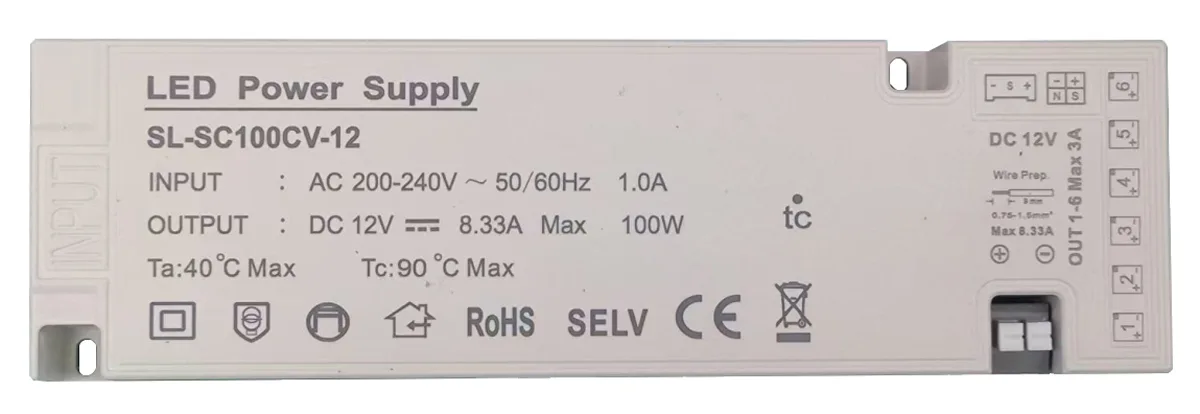
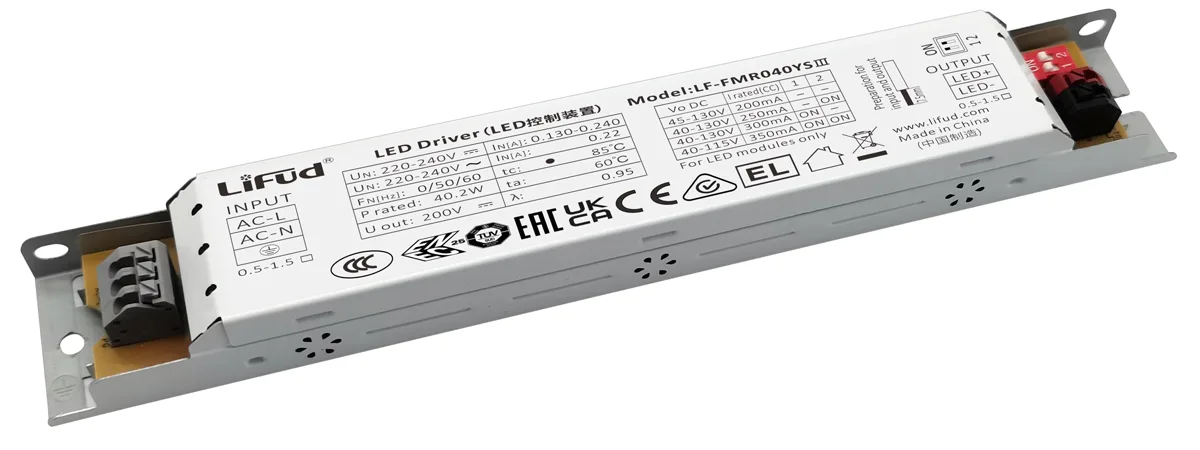




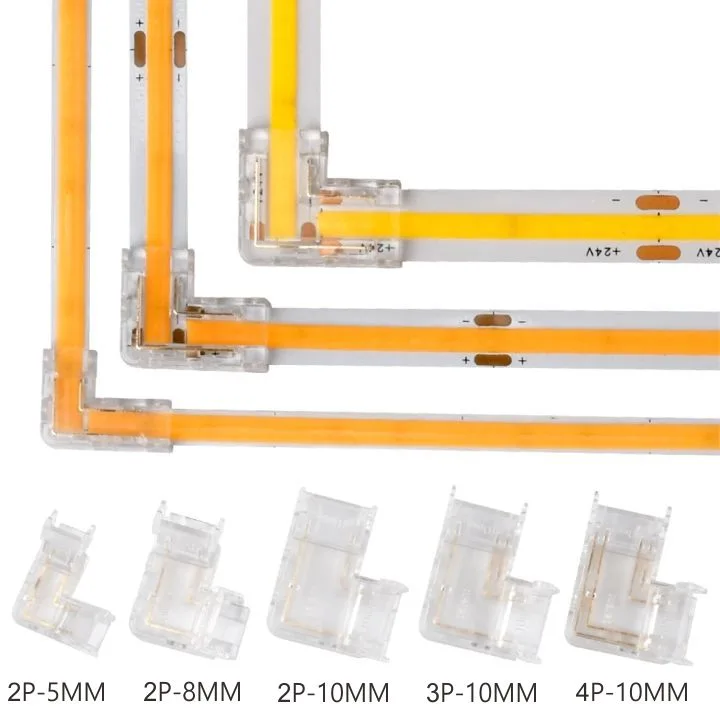


Về cơ bản, ai đó đã giúp một tay để thực hiện các bài đăng đáng kể mà tôi có thể nói rằng đó là lần đầu tiên tôi thường xuyên truy cập trang web của bạn và cho đến nay tôi ngạc nhiên với nghiên cứu mà bạn đã thực hiện để tạo ra công việc xuất sắc tuyệt vời này
Bài viết của bạn là một minh chứng thực sự cho chuyên môn và sự cống hiến của bạn cho nghề của bạn. Tôi liên tục bị ấn tượng bởi kiến thức sâu sắc của bạn và sự rõ ràng trong những lời giải thích của bạn. Tiếp tục công việc phi thường!